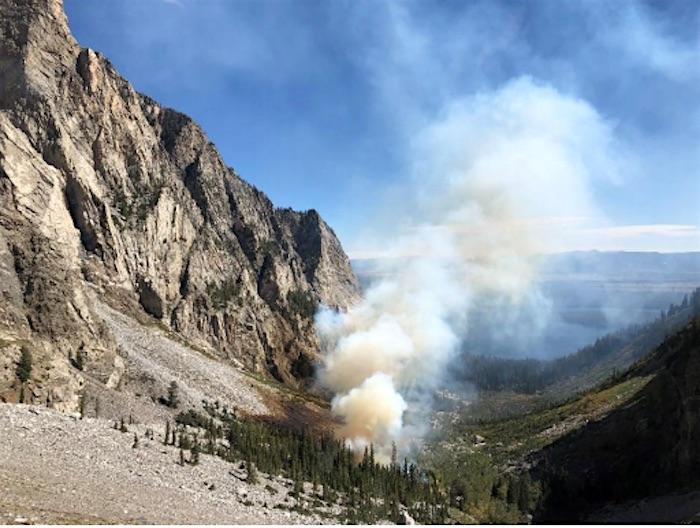
Fire danger at Grand Teton and Yellowstone national parks has been elevated to "very high." The Leigh Canyon fire (above) in Grand Teton has been burning in avalanche debris/NPS
Wetter and colder weather can't arrive soon enough for Grand Teton and Yellowstone national parks, where the fire danger has been elevated to "very high" for both parks. The same rating has been applied to the Bridger-Teton National Forest and the National Elk Refuge near Jackson, Wyoming.
Western Wyoming has seen exceptionally dry conditions since the last appreciable rain in late August, and fuel conditions are at their driest of the season, Grand Teton officials said Monday in a release. In addition, several days of red flag warnings have elevated local fire conditions.
A red flag warning is issued by the National Weather Service when relative humidity is expected to be at or below 15 percent and strong gusty winds are anticipated. These conditions are ideal for wildland fire combustion and rapid spread. Red flag warnings have been issued for the Teton Interagency and surrounding areas each day since late last week. Under these conditions, local residents and visitors alike should practice heightened fire safety at all times.
When the fire danger is very high, fires can start easily from both human-caused and natural causes and, immediately after ignition, spread rapidly and increase quickly in intensity. Small fires can quickly become large fires and be difficult to control. They often become longer-lasting fires, exhibiting extreme fire behavior and requiring more personnel and resources. When determining fire danger, fire managers use several indicators such as the moisture content of grasses, shrubs, and trees; projected weather conditions including temperatures and possible wind events; the ability of fire to spread after ignition; and availability of firefighting resources across the country.
Over the past several days, multiple fires have started on the Bridger-Teton National Forest and Grand Teton National Park. The two largest fires are the Roosevelt Fire on the Big Piney District and the Marten Creek Fire on the Greys River District, both located on the national forest. Additional fires are burning in Grand Teton National Park and the Blackrock and Pinedale Districts of the Bridger-Teton National Forest. For current information and media releases on any fires in the area, check the Teton Interagency Fire website.
At this time of the season, fire resources are stretched thin as employees finish their seasons and crews are released for the year. Many visitors and recreationists may drop their guard as nights get colder and fires season seems to wane. As hunting season picks up in the area, it is especially important to extinguish warming fires and campfires before leaving the area. Ensure all campfires are completely extinguished and cold to the touch before leaving your site. Visitors should never leave a fire unattended. The fine for an abandoned campfire is $225, but campers can also be held liable for suppression costs if their campfire becomes a wildfire.
To report a fire or smoke in the immediate area, call the Teton Interagency Fire Dispatch Center at 307.739.3630.



Add comment